Dira Abu el-Naga, located in the Theban Necropolis at Qurna, across the Nile from Luxor, was the burial place of some of the most prominent and influential men who held office during the 67-year reign of Ramesses II (1304-1237 B.C.); and among them were three High Priests of Amun.
Because of their control over the enormously rich treasury and estates of Amun-Re of Karnak, the chief god of the Egyptian empire, and in their capacity as chief prophets or interpreters of the god’s will, these Supreme Pontiffs wielded great political power and could affect the course of affairs of state. Throughout much of the New Kingdom, the prestige of this priesthood rivaled that of the Pharaoh himself. Priestly dynasties were established as a father’s offices were passed down to his sons, and members of distinguished families intermarried to consolidate and improve their social positions. Eventually, at the end of Dynasty XX, a semi-autonomous state emerged in the Theban area, ruled over by these priests. Some even styled themselves local monarchs and dated their monuments by the years of their own tenure or in terms of an era presumptuously called “the Renaissance.”

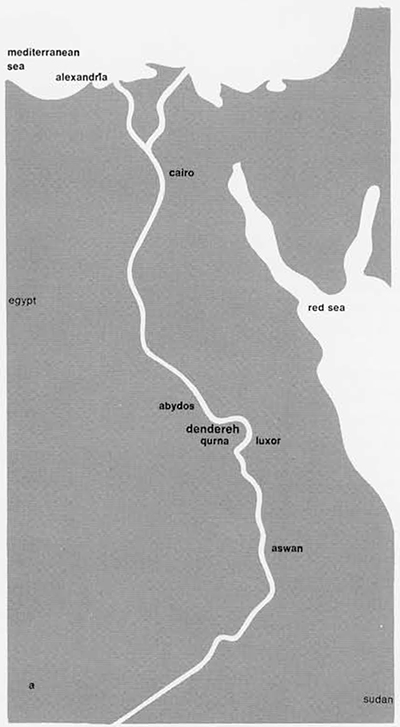

One of these High Priests, Nebwenenef, was appointed in the very first year of the Tong reign of Ramesses II. In an oracle interpreted by the youthful king when he went to Thebes to celebrate the great annual festival of Amun, the god himself insisted that of the candidates proposed as new chief officiant, only Nebwenenef would satisfy him. Nebwenenef was at that time High Priest of the god Onuris at Abydos and High Priest of the goddess Hathor of Dendereh. The king went to him immediately to announce the good news personally. In his tomb (No. 157) Nebwenenef relates this story and, in a famous relief, shows his audience with the King and Queen Nefertari at the palace for his formal installation. Nebwenenef was dead less than seventeen years later, when another is found as High Priest. So great was Nebwenenef’s honor that he was afforded the rare privilege of having his own mortuary temple on the plain below his tomb, near the temple of Seti I, the father of Ramesses II, under whom he had previously held office. During the whole of the New Kingdom, only one other commoner is known to have been granted this otherwise royal prerogative.
A somewhat younger colleague of Nebwenenef, Bekenkhons I, the owner of Tomb 35, was High Priest for 27 years near the end of the reign of Ramesses II. As a youth he also had served Seti I as overseer of his training stable. On a famous statue now preserved in Munich, Bekenkhons describes the more than eighty years of his lifetime and details the advancement of his career. He was the son of a renowned Second Prophet of Amun named Roma, who was still remembered at least seven generations after his death. Bekenkhons probably died before Ramesses II, as his successor, Roma-Roy, seems to have become High Priest in the very last years of that old king.
This Roma-Roy, whose tomb (No. 283) is almost completely ruined, may have been a son of Bekenkhons I—though there is no evidence to link them directly. He is known to have become Second Prophet of Amun under Ramesses II, and doubtless held this subordinate rank under Bekenkhons’ direction. Roma-Roy had a son also named Bekenkhons who, in his turn, became Second Prophet.
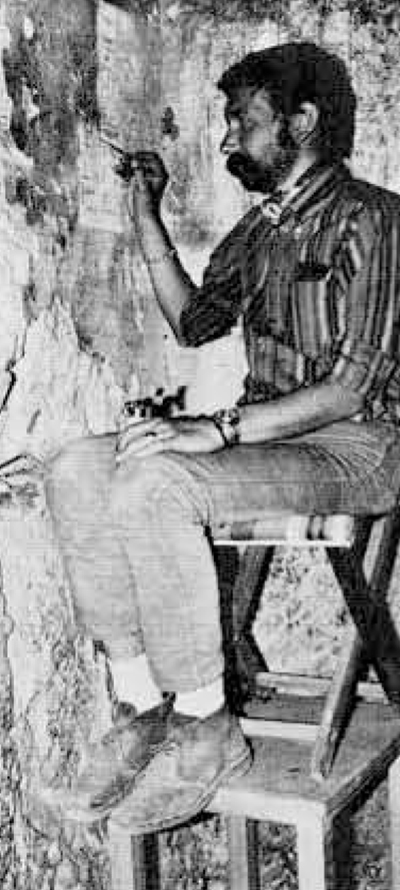
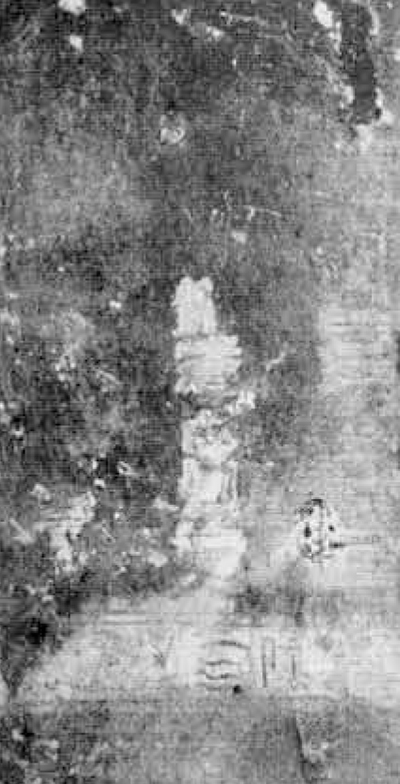

From 1921 to 1923 Clarence S. Fisher, then Curator of the Egyptian Section of the University Museum, directed a major excavation at Dira Abu el-Naga. In 1967, nearly fifty years later, we returned to this little known and much neglected site. Since then we have completed four campaigns there in the tombs of the High Priests.
Several general studies of the High Priests of Amun have appeared without benefit of reference to adequate copies of the inscriptions in the tombs of Nebwenenef and Bekenkhons. Thus, for a long time, confusion existed about the number of High Priests named Bekenkhons—with opinions varying from one to three (we now know there were two)—and about whether the Second
Prophet Roma was to be identified with the High Priest Roma-Roy or was a different person. Our project was organized originally to correct and complete the available copies of these texts. Our successes along these lines have made possible an improved interpretation of the meager stuff of which this history is made—names, dates, titles, and other scraps woven together into a sober narration of events.

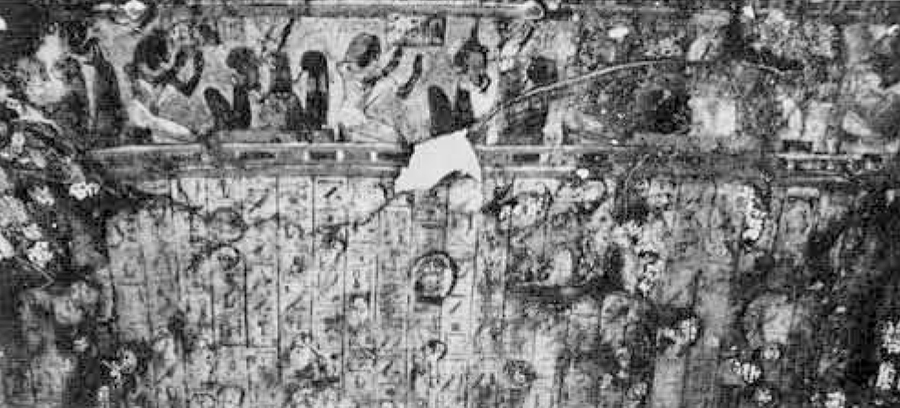
Once in the field, in response to the needs of these tombs, our approach broadened. We have tried to combine the skills of epigraphers, conservators, archaeologists, photographers, artists, and architects to strip away the shrouds of dirt and soot obscuring these tombs, bind up their various wounds, and slowly unlock the mysteries they have successfully concealed so long. Since the time of Champollion the tomb of Bekenkhons has been said to be extensively damaged or almost completely destroyed. We have demonstrated that much of its decoration still survives, eager to yield its secrets to the patient attention of the epigrapher and the firm but gentle hand of the conservator.
The work of the conservator has been described in earlier reports published in Expedition, but the progress has been great since then. Especially striking is the improved appearance and legibility of walls stripped of a secondary limewash which obscured them. When Christian monks took over this abandoned tomb they found its brightly painted pagan texts and pictures inappropriate to their needs. Rather than destroying these, however, they simply painted over them.
We, of course, are more interested in the hidden paintings. The technique of removal of the Coptic wash is simple but tedious. First the area to be cleaned is moistened with water from a spray atomizer, then scraped lightly with a surgical scalpel until color can be seen. Beyond this point keen judgment and manual dexterity are called for: the conservator must be able to recognize the exact interface between the overlay and the pigment beneath and clean away the one completely without injuring the other.
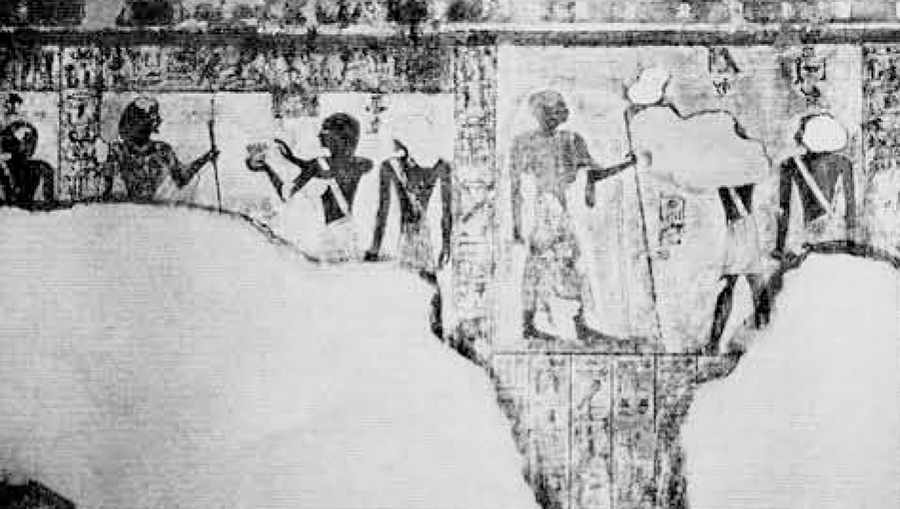

The work is time consuming, but we are indebted to the monks for their efforts. Their limewash was applied before the tomb had suffered much damage, so the subsequent fire and smoke affected only this outer layer. The walls which were protected in this way are now, after cleaning, the best preserved in the tomb.
When any painting is cleaned to its original surface, extreme care must be taken not to shift its pigments. The problem is increased when the paint has been severely damaged by heat and smoke, as is generally the case in Tomb 35. The blue pigment of the hieroglyphs is particularly unstable and tends to combine chemically with elements of the smoke and soot covering it so that the two become inseparable: the one cannot be removed without removing the other. To facilitate recognition and identification of figures and hieroglyphs, an artificially high contrast may be created between them and the plain white ground against which they stand. When a wall has been cleaned as far as possible by the application of liquid solvents, the painted features may be outlined and emphasized by erasure of the original, discolored background. This reveals the undamaged white lime plaster below, an effect completely consistent with the intended scheme of decoration.
Because the limestone fabric of this tomb is of poor quality, the surfaces of the walls were prepared for decoration by smoothing them over with a thick coat of mud mixed with straw and then finishing this with a fine lime and sand plaster. In order to preserve the painted plaster still adhering to the walls and ceilings of the tomb, we are replastering the walls which have lost their original covering. Thus, the loose and broken edges of the ancient plaster are supported from all sides by floating them in a bed of modern lime plaster, and decorated fragments are less likely to shift or fall. This work has been carried out largely by a local workforce under the supervision of the conservation staff. The only disagreeable side effect, for which no remedy has yet been found, is a slight staining of the edges of cleaned surfaces where they touch the fresh plaster. This is attributable to the underlying mud plaster, from which even the small amount of water used in our plaster brings forth impurities.


In the tomb of Nebwenenef occasional veins of good limestone permitted the ancient artists to carve reliefs of exceptional beauty. One of these, discovered in 1968, depicts the funeral procession of the High Priest himself. Cleaning has revealed many traces of the original color, adding important details which were not visible before. On another wall of this same tomb is an unusual “crossword” stela whose lower half had never been seen until we uncovered it in 1968. Nearby, in 1972, we recognized its ruined companion. Part of this second crossword stela was so precariously balanced in the wall that it could have fallen and been smashed. To prevent this disaster, the piece was cradled and removed from the wall, which will be prepared to receive it again next season.
Although the upper chambers of the tomb of Bekenkhons had been cleared by Fisher, the tomb of Nebwenenef was still clogged with up to six feet of debris, which concealed much of its walls, the floor plan, and many artifacts. At the same time the central rock-cut pillars carrying the massive weight of the ceiling needed immediate repair. In 1968, the central part of the broad-hall was cleared down to floor level to permit this rebuilding. At that time we observed that the debris was stratified and could be excavated stratigraphically to determine the circumstances of the deposition of its layers.
Some of the history of the tomb was already known. It was first occupied by Nebwenenef and his wife Takhat, whose burial was plundered probably not long after their deaths. The sack of the nearby tomb of a slightly later Third Prophet of Amun, Tjanefer (No. 158), is described in the Tomb Robbery Papyri of the late Twentieth Dynasty. These record the trials of several workmen accused of grave robbing who give, in their testimony, a vivid description of this unsavory occupation. At some undetermined time, probably before the Christian era, Nebwenenef’s tomb was used as a quarry: a piece of sandstone from the courtyard was carried off to Medinet Habu for reuse there. In the Christian period, the broad-hall of the tomb was used as a shrine, as the tomb of Bekenkhons was likewise reconsecrated; just fifty years ago the courtyard of this latter tomb was filled with ruins of many small Coptic cells.
The settlement at our site may have been associated with the large monastery of Deir el-Bakhit at Dira Abu el-Naga North.
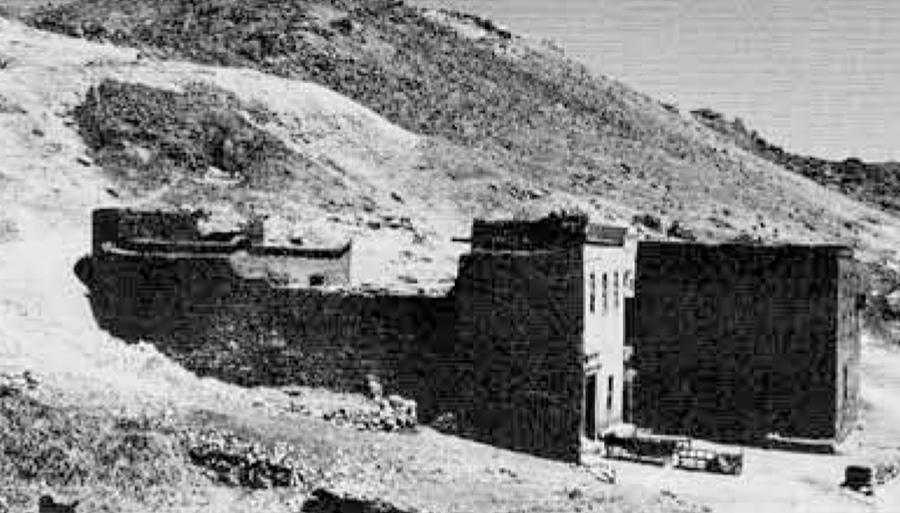
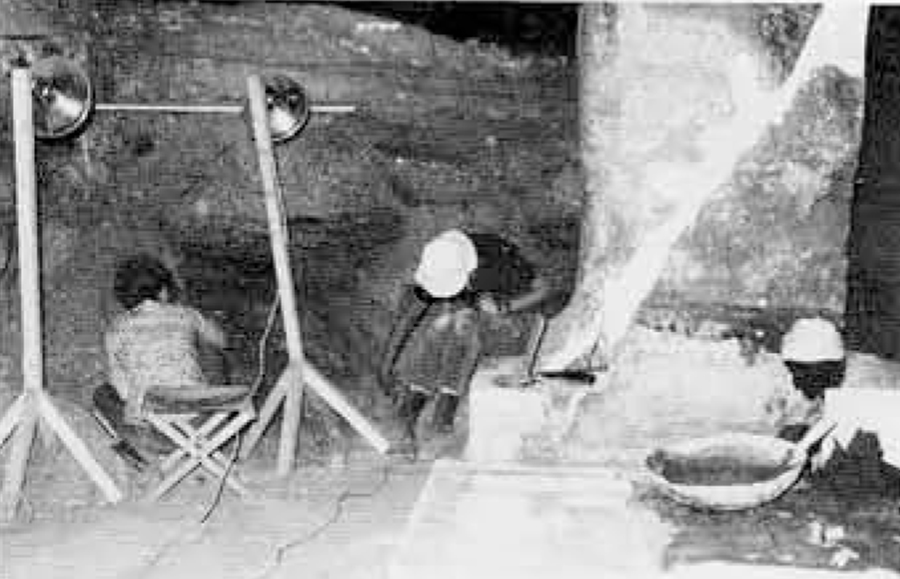

Then follows a great void, the dark ages of the tomb, until its discovery by Egyptologists in the nineteenth century. To fill this gap we have only the evidence of the debris piled up inside the tomb. From our clearance of 1968 we knew that the tomb had been occupied by people whose activities included tomb robbery and the manufacture of fake antiquities for sale on the tourist market. They seem,to have sorted their loot here, prior to disposing of it, and reburied incriminating evidence—including ransacked bodies—under their own rubbish heaps.
In 1905, the German scholar Kurt Sethe stopped by the tomb to copy its inscriptions for the files of the great hieroglyphic dictionary. Sometime after his visit the tomb was ravaged again, as he records part of a text which was later hacked out. Many pieces have been cut from the walls of this tomb and sold on the antiquities market. Two found their way to the British Museum, and others must have disappeared into private collections or lie unrecognized in public museums. Many more were smashed to bits as they were hastily wrenched out. The ineptitude of these vandals and their complete disregard for the art they trafficked in are witnessed by the large areas they destroyed to obtain small fragments of saleable quality. Most of the tombs of Dira Abu el-Naga are disfigured in this way to some degree. A piece from the tomb of Bekenkhons, for instance, is in the Yale University Art Gallery; and we have recently identified the nearby tomb of a minor official named Niay (No. 286) as the source for an attractive painting now in the Louvre. In order to avoid detection by the authorities of the Egyptian Antiquities Service (founded 1858), the thieves disguised the glaring white scars left by their crude assaults. In the tomb of Nebwenenef they filled these fresh gashes with mud and limestone chips from their own work. In the dark, dirty tomb this ruse proved sufficient.
By 1913, Tomb 157 had acquired a locked iron gate; and the former occupants were settled in a small mud-brick house in its courtyard. That house has been enlarged and another stands beside it now to fill practically the whole court. The inhabitants continue to fake antiquities and sometimes break up ancient monuments for their stone. The debris from this fakes industry and the rubbish dumped outside the houses—even the bread oven blackening a nearby mud-brick wall—suggest the continuation of a way of life amply attested in the tomb where their fathers and grandfathers lived.
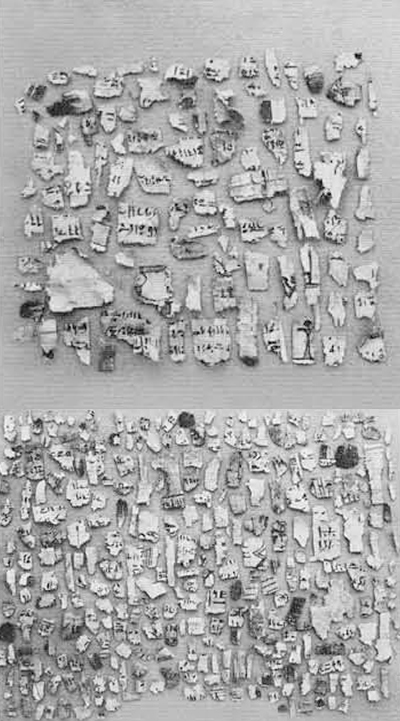


These houses are built over a three-foot deposit which must contain the remains of Coptic dwellings and original architectural features. We are currently negotiating to purchase these houses and relocate them, so we can excavate underneath.
When he left Dira Abu el-Naga, Clarence Fisher reckoned that only “about two weeks work on (the) next campaign” would be required to finish the excavation inside the tomb of Nebwenenef. Fortunately, the job remained for us; and we have proceeded somewhat more slowly than Fisher imagined.

The conditions of excavating underground have dictated the choice of methods used. A large Egyptian tomb resembles a mine or cave. Even if electricity has been installed, the available light is usually inadequate. Space is cramped and movement restricted; the farther one progresses away from the entrance, the closer the air becomes. Safety is always a major consideration, lest unsound rock collapse or deep crevices unload their burden of loose stones on a workman below. The caverns and tunnels are filled with fine sand and loose dirt; and the dust, once disturbed, hangs heavy in the air, obscuring vision, clouding photographs, and making breathing difficult. In 1972, we adopted face masks with dust filters of the kind used in mining operations. Given the soil conditions, baulks collapse easily and cannot be cut straight; they must be left sloping slightly. Strata may be distinguished and removed individually, but are mostly very soft and tend to bleed into one another; it is difficult to avoid some contamination from adjacent layers. The tools needed are the simplest: pointed and blunt-ended trowels, brushes, a scoop, an iron wedge for breaking up mud floors and hard-packed manure, and, most importantly, clever hands and fingers.
The combination of heavy dust and poor light, and the fact that many of our artifacts are of mud or earth colored, makes the recognition of objects in situ difficult—even bright blue faience may be overlooked. Though digging teams are small, consisting of one or two workmen and a professional archaeologist, and supervision immediate, all debris must be sieved. For practical reasons, this can be done only outdoors. The sieve is a table-like, wooden frame fitted with a screen of half-centimeter wire mesh, produced to specifications by a local carpenter. At full capacity two such sieves are worked by four local specialists under the direction of a professional staff member. Sieve duty is extremely important, but undeniably hot, dirty, and tiring; so a rotation schedule was devised to spread the work among as many staff members as possible. A canopy has also been erected to provide some shade as protection against the intense heat of the direct sunlight.
To prevent confusion, each basket load sent from a tomb is labeled with its area, trench, and level references. Only one basket at a time is examined in each sieve, and the sieve thoroughly emptied after each use. Finds from any context, whether discovered in the tomb or at the sieve, can be easily associated and coordinated; and broken artifacts can be joined together from pieces which appeared in both trench and sieve. If particularly interesting discoveries are being made at one end, word is passed back immediately to the other.



Minute evidence is thus saved from the oblivion of the dump. In 1970, in the courtyard of the tomb of Bekenkhons a shaft was reopened which had already been excavated. This time the debris was sifted, and in it was a small ebony inlay inscribed for the High Priest himself. During excavation in the burial tunnel of the tomb of Nebwenenef in 1972, when vast quantities of tiny fragments of inscribed papyrus were being found, only sieving prevented the loss of up to two-thirds of these pieces, which would have left hopeless any attempt to reconstruct the sheets from which they were broken. And this when the excavators were aware they were finding papyrus and were searching for it on hands and knees with extra lights, turning over the sand with their fingers and examining it time and again! With the dependability of our recovery system assured, we have labeled and saved all artifactual evidence for eventual restoration or statistical analysis.
In 1970, excavations in the broad-hall of Tomb 157 provided more information about the modern use of the tomb: a manger and rope tether for domestic animals, both associated with great quantities of clean, fresh-looking straw; a Turkish coin dated 1293 A.H. (= A.D. 1876), a large piece of limestone from the ceiling. On the underside of this stone, part of the original painted ceiling pattern is still preserved unburnt. The five feet of occupation debris piled up after it fell thus began to accumulate before the tomb was badly damaged by fire and smoke. In fact, it is probably the bread oven found near the top of this heap which is responsible for much of the damage visible now.
In 1968, we found a shawabti fragment bearing the name of Nebwenenef. This small object has had an interesting history since its discovery. It was among the few things stolen from our on-site magazine sometime between April 1968 and February 1970, was sold on the Luxor market, and came to the United States. Later it was called to our attention by Dr. Carl E. DeVries, an Egyptologist then on the staff of Chicago House at Luxor. He had secured it himself and agreed to send it to us. In 1972, I took this well-traveled shawabti with me back to Cairo to present to the Egyptian Antiquities Service in the name of the University Museum; and we were allowed to return it to our magazine for further study. We have since fortified this magazine, and it is now much more secure and is guarded by our special watchman.

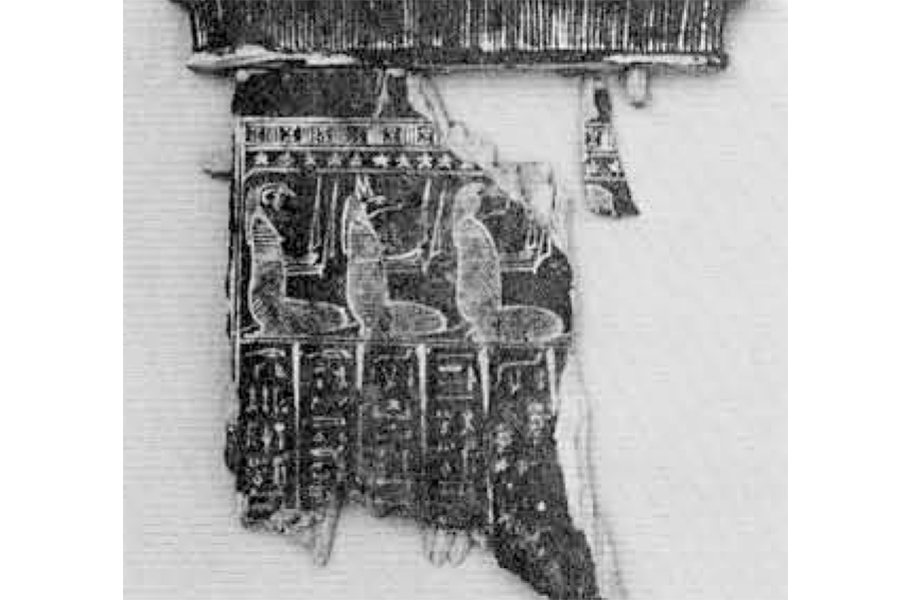

In 1970, nothing more inscribed for Nebwenenef came to light. The burial tunnel of his tomb, however, like that of Bekenkhons, had never been excavated. These winding tunnels, located near the back of the tombs, were not so accessible nor as suitable for reuse as the upper rooms. We hoped that in the chambers at the end of the tunnels, where the mummies of the High Priests and their wives originally lay, some of their burial equipment might have survived. In 1972, we set to work in both of them.
The tunnel in the tomb of Bekenkhons is about 32.5 meters, roughly 100 feet, long and was cleared except for a large pit in the floor of the burial chamber itself. Although it must have been reused and filled with later burials, no stratified deposits remained, as the rubble had been churned up by generations of modern robbers. These plunderers left no stone unturned and took almost every object of material value. Of scholarly interest, however, were fragments of the white faience canopic jars of the Chief Steward of the Lord of the Two Lands and Overseer of the Granary, Thutmose; a small ram-headed stick representing an implement used in the funerary ceremony called the “Opening of the Mouth”; the lower part of the face from a life-sized limestone statue of a god or king; hundreds of mud and fired clay shawabtis, some inscribed, nearly every one broken; and a silver signet ring.
New evidence from the time of Bekenkhons is limited to one shawabti fragment and pieces of a red granite sarcophagus. The shawabti does not mention its owner; but in the Egyptian collection of the University Museum, from the first Dira Abu el-Naga excavations, is a similar figure with the name of the High Priest on it. The two pieces surely come from a single object and may match perfectly.
The sarcophagus probably belongs not to Bekenkhons but to his wife Mertseger. Part of its base was found lying still in situ in a shallow depression cut for it in the floor of the burial chamber. This coffin has been smashed repeatedly during successive tomb robberies, both ancient and modern; and pieces of it were strewn throughout most of the burial tunnel, far from its original resting place. The pieces range in size down to tiny nondescript chunks of granite. We saved every bit we could lay hands on, not with the thought of ever reconstructing it—which would be impossible—but to weigh it.
In the collections of the Museums of the City of Liverpool, where it has been since the middle of the last century, is the magnificent red granite sarcophagus of a High Priest Bekenkhons. Doubt has naturally existed whether to attribute it to Bekenkhons I or II. That it belongs to our Bekenkhons seems fairly likely, since the tomb of his later namesake is unknown; but the suggestion remains to be demonstrated conclusively. Unfortunately, it was destroyed during World War II, when the museum building suffered a direct hit. All the pieces are safe, however, lying on a gallery floor awaiting a promised and long hoped for restoration. Meanwhile, we have been given an estimate of its weight as “something in excess of two tons.” This will permit us to calculate whether there are enough fragments in our tomb for two sarcophagi or one. If only one, as I expect, this must be Mertseger’s; and the likelihood is increased that the other in Liverpool belongs to Bekenkhons I.


The tomb of Nebwenenef is much larger than that of Bekenkhons. The tunnel is 100 meters long, about 300 feet, and leads down with stairways and ramps to a subterranean pillared hall before the actual burial chamber. In modern times the tomb has been plundered from the burial chamber outwards, and the very length of the tunnel afforded some protection to the artifacts hidden in it. The upper reaches were inhabited during one of the three distinct periods in the history of its use.
Immediately on top of the floor is a layer of clean sand blown in through the cracks in the ceiling, a phenomenon which still occurs. In it are bits of floral wreaths, mummy wrappings, and bone chips from the later burials made in the tomb of this illustrious High Priest. The guano mixed in and on top of it tells us that the bats now living here had already arrived. It was in association with this level that most of our important finds were made. Although the tomb and its intrusive burials were being repeatedly looted, this was at a time before there was a thriving antiquities market; and many objects of antiquarian interest remained.
Above this the color and composition of the soil changes completely as we encounter once more the dark organic deposit indicative of human occupation. Much of the debris found here may have been thrown down as refuse from the habitation above. On the surface, after this part of the tomb had been abandoned, is a mixture of bat guano with loose sand and dirt, mud bricks and lumps of stone.
In the course of our season, which extended from February to May this year, we excavated the first twenty meters of this tunnel. Among the miscellaneous finds are a small lapis lazuli seal of Amun in the form of a ram, an animal sacred to this god; countless papyrus fragments of several documents from different periods; an intact pilgrim flask; a set of green faience shawabtis of a man named Bakkhonsu; a late uninscribed offering table decorated with extremely fine relief; a false beard and plumed crown from gilt wooden statues of gods; a collection of painted wooden Ba and Sokar birds, of funerary function; and a Hellenistic painted terracotta head. All of these objects probably come from burials made later than that of Nebwenenef.
The broken and scattered contents recovered from one such intrusive burial give us a good impression of its original appearance. As one section of the tunnel was being cleared, the floor suddenly gave way to soft fill. As the top of a pit was outlined, a crack appeared at the wall, revealing a subsidiary chamber. The pit was excavated and led to a small room under the wall of the tomb, whose entrance had been blocked by a mud-brick wall; this proved to be an intrusive burial. In the debris on the floor above we could trace the hole which robbers had dug into the burial pit. Though this crypt had been entered in comparatively modern times, the persons who disturbed it last left many of its contents behind. The difficulties of working in such close quarters by torch light surely reduced their efficiency, but they must have been there before all ancient Egyptian objects had a market value. The coffins, for instance, were hacked to pieces for their wood. We identified the owner as the Third Prophet of Amun Ankhefenkhonsu, son of the priest Nesm in and his wife the sistrum player Taisheru. Along with many other objects, we found evidence for his outer and inner painted wooden coffins, a cartonnage coffin nested inside these, and yards and yards of inscribed mummy wrappings, a decorated shawabti box, and a single blue faience shawabti of his. In addition, the thieves missed some small pieces of thin beaten electrum, an alloy of gold and silver. These were impressed with designs, including a rosette and one of the Four Sons of Horus, the funerary deities who were thought to protect parts of the embalmed body. By the style of his burial goods, Ankhefenkhonsu may be dated to about 250 B.C.
We had already found an intact papyrus roll, which turned out to be a Book of the Dead inscribed for a certain sistrum player of Amun, Mutirdis, daughter of the priest Khnemibre and the sistrum player Tawagesh. It must have come originally from another intrusive burial which we have not yet identified. It was somehow dropped and landed near the wall of the tunnel, and so was spared being trod on—else we should have had several thousand more papyrus fragments to deal with. When we unrolled it, we found that it is very well preserved to its entire six-foot length. Near the inner end is a single large vignette showing Mutirdis being offered to, and illustrating events from the afterlife. On the reverse is a single docket identifying the owner and her parents. The names of her father and mother point to a date in the late Ptolemaic period or even Roman times; but this has not yet been fixed. We built a frame and mounted the papyrus between sheets of glass for study.
From the time of Nebwenenef, we found the bezel of a blue faience ring of Ramesses II. Though we cannot guarantee this to have come from the burial of Nebwenenef himself, it seems probable: his name is associated with that of Ramesses on small faience plaques from the foundation deposits of his mortuary temple. But the most important find of our whole excavation is a stunning black granite bust of Nebwenenef’s wife Takhat. Her name is not upon it, but his is, assuring us that this is his wife, depicted many times in the tomb. Her beautiful portrait is sensitively styled and shows great care in the depiction of her wig and gown. Her face is nearly perfect. Shallow cracks opened in the granite and its surface was dulled when the statue was burned, at sometime prior to being thrown down the burial shaft. Our conservatress, who also opened the papyrus roll, cleaned and waxed the statue to restore some of its original lustre.
To our great pleasure we have been able to locate the statue base from which this head comes. In 1941, it was in St. George’s Monastery in Old Cairo, near the Coptic Museum. Though its provenance was unknown, it had been seen in Cairo and reported as early as 1881. From the published photographs and copies of its inscriptions, our piece certainly belongs to it and may join perfectly. The statue is near life size and depicts Nebwenenef seated beside his wife. His head has never been identified, and may be among the many disembodied heads in the world’s Egyptian collections. Or it may be waiting in the tomb.
We have now to revise the biographies of Nebwenenef, Bekenkhons I and II, and Roma-Roy, to reevaluate their places within the succession of High Priests of Amun during Dynasties XIX and XX (1320-1085 B.C.). We expect to go back to the tombs of Dira Abu el-Naga again in 1974. Meanwhile, progress continues to be made in the study of all the artifacts and other data so far recovered by us. In 1968, for instance, we excavated a fragment which was published as “a charred piece of Coptic painted wood, with a face drawn on it.” We have since learned that this is all that is left of an extraordinary large, early cross, perhaps used in Christian services at Nebwenenef’s tomb; and the face upon it may represent one of the Evangelists, possibly Matthew.
